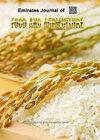Chitosan-only nanoparticles against phytopathogenic fungi in the past decade (2013–2023)
IF 0.7
4区 农林科学
Q3 AGRONOMY
引用次数: 0
Abstract
Chitosan is a biocompatible, biodegradable, and antimicrobial polymer. Researchers have recently explored using chitosan nanoparticles to fight phytopathogenic fungi. This review aims to provide a comprehensive overview of studies conducted between 2013 and 2023 using the most popular databases for academic research on this topic. A systematic review was conducted using Software Rayyan to support the process. The search was conducted using the Web of Science, Scopus, and ScienceDirect databases. Out of the 752 records found from 2013–2023, only 83 articles were considered eligible for inclusion in the review after screening with inclusion and exclusion criteria. Most studies showed that chitosan nanoparticles are produced using sodium tripolyphosphate (TPP) through ionotropic gelation. However, using TPP has potential drawbacks and may have a synergistic effect with chitosan, which requires further investigation. TPP can affect the biological activity of the nanoparticle matrix. Furthermore, less than 10 out of the 83 articles reviewed in the time frame explored chitosan-only nanoparticles (nanochitosan) against phytopathogenic fungi. This shows the need for more research to determine the potential benefits of chitosan-only nanoparticles in control phytopathogenic fungi.过去十年(2013-2023 年)纯壳聚糖纳米颗粒抗植物病原真菌的情况
壳聚糖是一种生物相容性、可生物降解的抗菌聚合物。最近,研究人员探索使用壳聚糖纳米粒子来对抗植物病原真菌。本综述旨在利用最流行的学术研究数据库,全面概述 2013 年至 2023 年期间进行的相关研究。我们使用 Rayyan 软件进行了系统性综述。搜索使用了 Web of Science、Scopus 和 ScienceDirect 数据库。在 2013-2023 年期间找到的 752 条记录中,经过纳入和排除标准的筛选,只有 83 篇文章被认为符合纳入综述的条件。大多数研究表明,壳聚糖纳米粒子是利用三聚磷酸钠(TPP)通过离子凝胶法生产的。然而,使用 TPP 有潜在的缺点,可能会与壳聚糖产生协同效应,这需要进一步研究。TPP 会影响纳米粒子基质的生物活性。此外,在这段时间内查阅的 83 篇文章中,只有不到 10 篇探讨了纯壳聚糖纳米粒子(纳米壳聚糖)对植物病原真菌的作用。这表明需要进行更多的研究,以确定纯壳聚糖纳米粒子在控制植物病原真菌方面的潜在益处。
本文章由计算机程序翻译,如有差异,请以英文原文为准。
求助全文
约1分钟内获得全文
求助全文
来源期刊

Emirates Journal of Food and Agriculture
AGRONOMYFOOD SCIENCE & TECHNOLOGY&nb-FOOD SCIENCE & TECHNOLOGY
CiteScore
1.80
自引率
0.00%
发文量
18
期刊介绍:
The "Emirates Journal of Food and Agriculture [EJFA]" is a unique, peer-reviewed Journal of Food and Agriculture publishing basic and applied research articles in the field of agricultural and food sciences by the College of Food and Agriculture, United Arab Emirates University, United Arab Emirates.
文献相关原料
| 公司名称 | 产品信息 | 采购帮参考价格 |
|---|
 求助内容:
求助内容: 应助结果提醒方式:
应助结果提醒方式:


